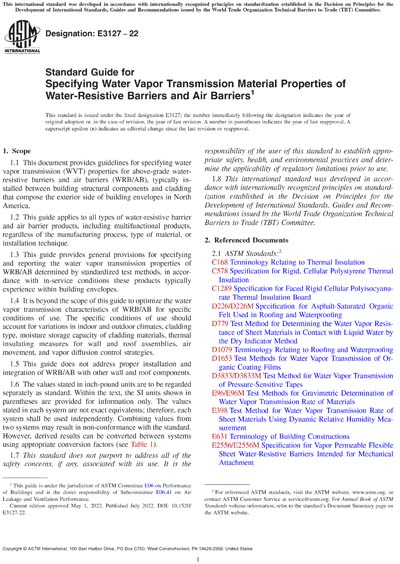Historical
ASTM E3127-22
Standard Guide for Specifying Water Vapor Transmission Material Properties of Water-Resistive Barriers and Air Barriers
1.1This document provides guidelines for specifying water vapor transmission (WVT) properties for above-grade water-resistive barriers and air barriers (WRB/AB), typically installed between building structural components and cladding that compose the exterior side of building envelopes in North America.
1.2This guide applies to all types of water-resistive barrier and air barrier products, including multifunctional products, regardless of the manufacturing process, type of material, or installation technique.
1.3This guide provides general provisions for specifying and reporting the water vapor transmission properties of WRB/AB determined by standardized test methods, in accordance with in-service conditions these products typically experience within building envelopes.
1.4It is beyond the scope of this guide to optimize the water vapor transmission characteristics of WRB/AB for specific conditions of use. The specific conditions of use should account for variations in indoor and outdoor climates, cladding type, moisture storage capacity of cladding materials, thermal insulating measures for wall and roof assemblies, air movement, and vapor diffusion control strategies.
1.5This guide does not address proper installation and integration of WRB/AB with other wall and roof components.
1.6The values stated in inch-pound units are to be regarded separately as standard. Within the text, the SI units shown in parentheses are provided for information only. The values stated in each system are not exact equivalents; therefore, each system shall be used independently. Combining values from two systems may result in non-conformance with the standard. However, derived results can be converted between systems using appropriate conversion factors (see Table 1).
1.7This standard does not purport to address all of the safety concerns, if any, associated with its use. It is the responsibility of the user of this standard to establish appropriate safety, health, and environmental practices and determine the applicability of regulatory limitations prior to use.
1.8This international standard was developed in accordance with internationally recognized principles on standardization established in the Decision on Principles for the Development of International Standards, Guides and Recommendations issued by the World Trade Organization Technical Barriers to Trade (TBT) Committee.
Content Provider
ASTM International [astm]






